Most economists will tell you that the global economy is an incomprehensibly complex, dynamic and interconnected system that no human can hope to fully understand.
The Trump administration has taken this message to heart, seemingly deploying a primary school-level equation to calculate its ‘Liberation Day’ reciprocal tariffs that have sent global markets tumbling in a move described by experts as ‘insane’ and ‘full-on crazy’.
Speaking in the White House‘s Rose Garden yesterday evening, Donald Trump said that the rate of his tariffs for each nation had been conjured up by taking into account the ‘combined rate of all their tariffs, non-monetary barriers and other forms of cheating’.
A White House official later insisted that the rates were ‘the fairest thing in the world’, adding the figures had been agreed by the Council of Economic Advisers based on ‘the sum of all trade practices’ by other countries – in other words, an incredibly intricate and detailed web of different measures and controls.
However, it appears Trump’s advisers arrived at their figures like so:
Take the total trade deficit America has with a given country. Divide that number by the value of that country’s exports to the US.
Then divide whatever number that is by half out of ‘kindness’.
Take China, for example, with which America ran a trade deficit last year of $291.9 billion. Beijing exported $433.8 billion in goods to the US. Divide the former figure by the latter and you’re left with a number of 0.6728 – otherwise represented as 67%.
That’s the tariff percentage the US claims China imposes on all trade from Washington. Cut that figure in half and you’re left with 33.5%.
Round that up and you have 34% – the exact tariff rate the Trump administration slapped on China.
This horrifyingly simple approach – applied to many of the countries on the list – was first cracked by financial journalist James Surowiecki in a post on X, prompting a slew of other analysts and experts to lambast the Trump administration’s calculations.
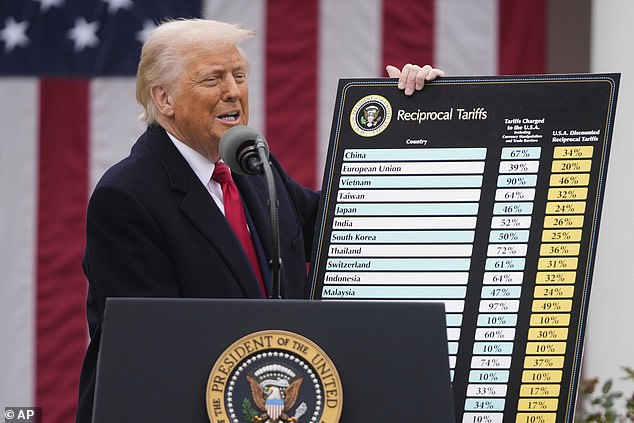
President Donald Trump holds up a giant chart showing some of the reciprocal tariffs his administration plans to charge foreign countries. Every country will be charged at least a 10 percent tariff to import goods to the U.S.
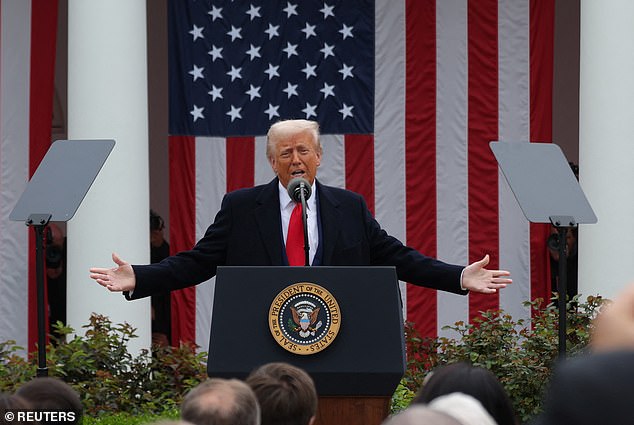
Donald Trump confirmed that the UK will not escape the pain of levies he claims will restore ‘fairness’ in global trade
Paul Krugman, Professor of Economics at the City University of New York said Trump had gone ‘full-on crazy’, while Scott Lincicome, vice president of general economics at the Cato Institute, responded to the confirmation on X writing: ‘This is insane.’
Vice President of Federal Tax Policy with the Tax Foundation think tank Erica York added: ‘This is just embarrassing’.
And Stephen Innes, Managing Partner of SPI Asset Management, said: ‘President Trump walked into the Rose Garden and detonated the most aggressive trade shock the market’s seen in decades. This isn’t a jab – it’s a full-on haymaker.’
In the wake of Trump’s announcement, the US Trade Representative issued a statement defending the approach to tariff calculations.
It said that the calculations had ‘proxied’ the combined effects of a country’s trade practices in relation to the US, arguing that ‘individually computing the trade deficit effects of tens of thousands of tariff, regulatory, tax and other policies in each country is complex, if not impossible’.
But this argument was dismissed as an excuse by Emily Kilcrease, the director of the Energy, Economics and Security Program at the Center for a New American Security and a former deputy assistant US trade representative.
‘It was always going to be a really difficult exercise to come up with a very precise reciprocal tariff rate,’ she told The New York Times.
‘Given what seems to be their desire to get something out quickly, it appears what they’ve done is come up with an approximation that is consistent with their policy goals.’
Other analysts pointed out that the calculations appeared only to take into consideration the total value of goods when it comes to America’s trade deficit and omitted the value of services.
This oversight could leave the US vulnerable to retaliation – particularly America’s booming tech companies.
They fall into the services category, where the US exports considerably more than it imports to many partners, including the EU.
It is worth noting that not all countries were subjected to Trump’s sweeping tariff calculations.
Many, including the UK, will only have to contend with a base rate tariff of 10% applied by Trump on foreign goods imported to the US.
But the equation proposed by Surowiecki returned correct results for at least two dozen of the countries listed on the Liberation Day tariff sheets, and within one or two percentage points for another two dozen, according to the FT.
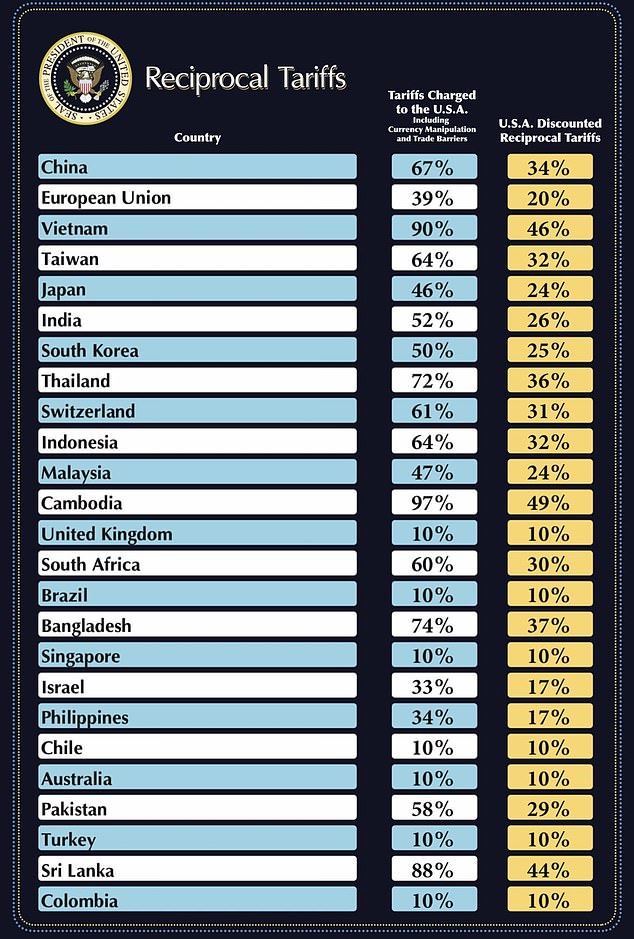
The first of eight pages of reciprocal tariffs that the White House announced during Wednesday’s event in the Rose Garden
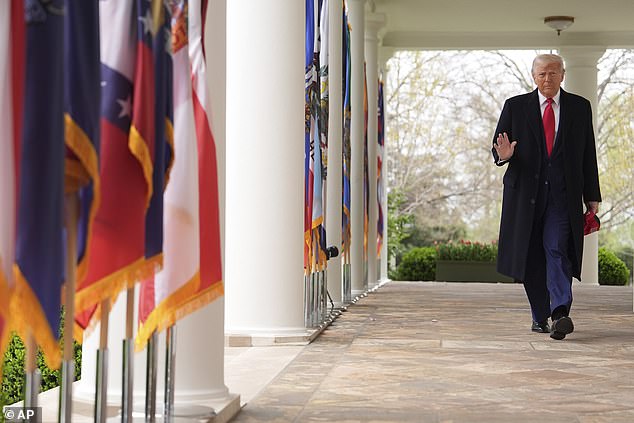
Mr Trump appeared to have deliberately waited until markets were closed to make his announcement
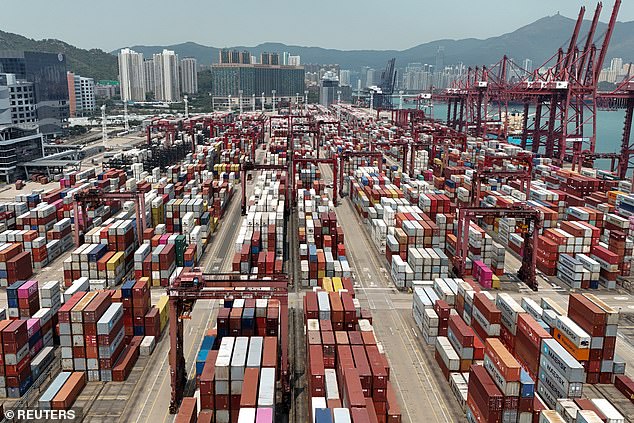
A drone view shows containers at the terminals at the port in Kwai Chung in Hong Kong, China, April 3, 2025
Trump’s policy of reciprocal tariffs is born from his long-held belief that the US is being ripped off – and that the trade deficit with foreign nations is the clearest indicator of this and must be eliminated.
But many analysts argue that the US trade deficit doesn’t simply mean that countries worldwide have been taking advantage of Washington with unfair trade agreements, cheap imports and downright cheating.
Rather, the US trade deficit is affected by a huge number of factors, not least America’s huge debt – which currently sits around 5.5% of GDP – and decades of globalisation in which the US itself outsourced manufacturing and sought to drive down labour costs.
Trump insists the import taxes on foreign nations and economic blocs, ranging from 10% to 49%, would draw factories and jobs back to the US and do to other countries what he says they have long done to America.
‘For decades, our country has been looted, pillaged, raped and plundered by nations near and far, both friend and foe alike,’ Trump said in his White House remarks, which ran for 49 minutes.
The administration cited the US trade deficit as the legal justification for the ‘national emergency’ allowing Trump to impose the tariffs.
‘Taxpayers have been ripped off for more than 50 years,’ he said. ‘But it is not going to happen anymore.’
Dr James Scott, an expert on trade governance and Reader in International Politics at King’s College London’s Department of Political Economy, said Trump had drummed up support for his policies by tapping into ‘resentment and anger’ created by his predecessors’ economic decisions.
‘Outsourcing manufacturing jobs, privileging consumer prices over jobs and subjecting low-income workers to ever greater competition with workers elsewhere – these are all policy choices, not inevitabilities,’ he wrote in a newsletter for KCL.
‘There are identifiable objectives that he wants to achieve, but his policies for doing so are very unlikely to work’, Scott concluded.







